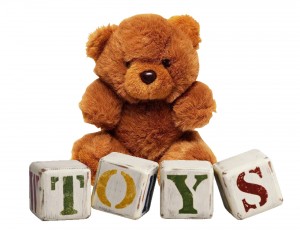
Source: Free Pub Trivia
Toy buying is often a minefield for feminist parents.
Many parents ask me something along the lines of, “OH NO! My daughter loves [fill in girly, pink, princess toy here]! What do I do?”
There is a great deal of fear that having a daughter that loves to play princess or dolls is somehow a failure of feminist parenting (and although I’m focusing on girls in this article, the converse is true for boys).
The idea is that in order to teach them the misogyny of the pink aisle, we need to forbid Barbie and her friends.
On the contrary, I’m not in favor of “forbidding” toys.
The forbidden is even more attractive, and the concept of forbidding something precludes the type of respectful, consensual parenting we’re aiming for.
I’m also not interested in shaming girls for their preferences.
There is nothing wrong with loving pink or fashion or princesses. When I write about the problems with the “girl toy/boy toy” dichotomy, my complaint is with the toy industry for limiting kids in narrow boxes, not with the individual choices of families.
Have you seen or heard about Goldie Blox?
Goldie Blox is a game designed by an engineering student at Stanford, Debbie Sterling, to get girls building. You can see her explain why she created Goldie Blox here.
I bought one before they were even in production when it was just a Kickstarter project, and I’ve been saving it for my daughter’s fifth birthday (this February!). I point this out to say that I had already heard of Goldie Blox prior to the recent hubub.
Goldie Blox received a bunch of notoriety lately for its commercial set to the tune of the Beastie Boys’ “Girls,” but with a group of young girls singing about how they don’t want dolls and pink stuff.
(Here is the original version. The Goldie Blox site now has a version without the Beastie Boys song, due to a legal dispute with the band.)
While the song plays, the girls launch an impressive, house-spanning Rube Goldberg machine (remember Doc’s alarm clock/breakfast setup in Back to the Future? That’s a Rube Goldberg machine).
Most mainstream coverage just loved it!
It has all the trappings of girl power plus a catchy song that is popular with the demographic (*cough* me) that is currently buying toys for their young girls. Feminist parenting circles had both positive and negative things to say about the toy.
In a recent conversation about Goldie Blox, a friend, as a mother of sons, she didn’t see the point of “girl” toys and stated she’d rather just buy gender-neutral.
I realized, as the author of a book called “Gender-neutral” parenting, it might sound like something I’d say – that buying a “girls only” toy is sexist and teaches kids the wrong thing.
I can certainly see that the toy is still pink! And it features a princess – a blonde, blue-eyed princess! It also places the blame for the dearth of women in STEM fields as being a problem of female exceptionalism instead of male privilege.
It is easy to focus on how well the toy fits into the stereotypes of the pink aisle at the toy store instead of how it breaks the mold of the pink aisle.
Goldie Blox is a great example of a toy that actually has an important role in the current toy industry. And I’m here to tell you there is nothing wrong with buying this toy for your kids.
Here’s why I think that toys like Goldie Blox can be better ideas than buying strictly gender-neutral:
1. Gender-Neutral Parenting (GNP) Isn’t About Gender-Neutral Toys
As I mention in the book, I do prefer the non-pink version of things because just slapping pink on a toy and calling it “girl” is insulting to girls (and boys).
However, that is not the primary aim of GNP toy purchasing.
The primary purpose is to break down gender stereotypes (cooking is for girls, cars are for boys) and compensate for possible, implicit bias in all genders.
This means going out of your way to get your girls engaged in large motor skills like kicking, running, and jumping because we (parents and society) may implicitly ignore these skills in our verbal girls.
It also means going out of your way to engage your boys in storytelling and reading because we may implicitly ignore these skills in our physical boys.
Remember, too: The “gender-neutral” in GNP doesn’t mean gender-neutral children. Rather, it is about gender-neutral parenting strategies and choices.
2. STEM is an Area of Strong Implicit (and Explicit) Bias for Girls
STEM – science, technology, engineering, and mathematics – is comprised of only 11% females. There is a clear social bias at work that makes excelling at these fields difficult for girls.
There are many problems at play here, but one is the genderization of toys.
Building toys are primarily the realm of boys. If you go to a toy store they will be in the “blue” aisle.
This morning, I did an Amazon search for “engineering toys” — it was wonderful to see Goldie Blox in the #1 slot! Most, however, are clearly marketed to boys:
You can say “Those aren’t boy toys, they are gender-neutral! I’d just buy them for my girls!” and you’d be right to an extent.
Those toys are perfectly fine for girls or boys. We don’t need to pay attention to the marketing of stores that say this is for boys and this is for girls. Most feminist parents ignore the marketing and buy what they think best anyway.
However, if you live in the real world with real kids, the kids are going to know what boy toys and girl toys are. Ask the average second grade boy to play with a doll and see what he says!
When the social cues that our kids learn – even if they aren’t from us – strongly gender something, it becomes necessary to compensate in some way.
For example, one area where boys are disadvantaged is in reading and writing.
The idea of a diary or journal is very popular for girls, but rarely marketed for boys. In this case, I would try something like this boy-centric journal to get my sons writing.
If my girls are going to be turned off by engineering toys they deem “boy toys,” then buying one designed to appeal to girls is a great idea.
3. Pink Does Not a Girl Toy Make
So, let’s look at the prevailing thought for making engineering toys appeal to girls.
If you have a girl who likes pink, this might work, but the vast majority of girls aren’t going to be fooled by a change in color. (I am all for buying the pink ones if your child wants it; choosing stereotypical “girl” things is a valid choice to be respected.)
Worse, many kids are just insulted! As if girls are saying, “If only there were more pink to be a scientist!”
You can’t only dip something in pink and say you are appealing to girls. It is insulting and does little to change the gap in female STEM careers.
4. Completely Neutral Sexism Is Like Completely Colorblind Racism: It Isn’t
If you are involved in racial justice, you’ll know that “colorblind” is the new racist mantra. It often goes hand-in-hand with the concept of “reverse racism.”
In a world with complete equality – where people of all colors have completely equal opportunity – then maybe race won’t be an issue. We don’t live in that world, so to deny race is really to back the status quo, that is, white privilege and non-white oppression.
Part of leveling the playing field to reduce inequality is about compensating for racism not ignoring it.
The same goes for gender.
If we say anything “for girls” is sexist and we should just ignore gender, then we are strengthening the sexist status quo.
There is a clear inequality in STEM for girls. Part of leveling the playing field is to have programs that encourage girls in these areas (and it is important to encourage boys in areas where they are disadvantaged, too).
A girl-centric toy for engineering is warranted by the documented inequality in the field.
“But it’s sexist against boys!”
I’ve heard that “My son would love it, but…” argument, the “but” being that he doesn’t want to play with a pink toy. Why is that? Because pink is for girls and being a girl is less valued than being a boy?
Maybe it would do our sons good to play with pink? Maybe boys would benefit from the storytelling side of Goldie Blox? I agree. Someone should start a Kickstarter project to add verbal, storytelling, and nurturing themes into “boy toys.” That doesn’t make Goldie Blox sexist against boys.
On the surface, a pink toy annoys me.
I don’t really like pastel colors in general, and I find it insulting that girl things are all a range of pink and lavender. However, that isn’t the sum of a whole toy.
Goldie Blox was created after researching how girls play.
Girls are verbal and like storytelling (whether that is biological or just socially reinforced is irrelevant as long as it just is). What Goldie Blox does is take that concept and make a story-led, girl-centric game that uses engineering skills.
Do I wish it weren’t pastel (it is mostly blue)? Maybe.
I don’t personally like the colors, but, once again, Goldie Blox used research to find colors that would appeal to the most girls. If making it baby blue and pink helps more girls be exposed to it, then I’m all for it.
Someday we won’t need gendered toys. Today is not that day.
What do you think?
Want to discuss this further? Login to our online forum and start a post! If you’re not already registered as a forum user, please register first here.
Paige Lucas-Stannard is a Contributing Writer for Everyday Feminism. She’s a parenting educator and writer and the founder of ParentingGently.com, which offers resources to help progressive parents find their authentic voices and implement respectful, values-based (and fun!) parenting in their homes including her new book, Gender Neutral Parenting: Raising kids with the freedom to be themselves. Follow her on Twitter @babydust, on Facebook, and on Pinterest.Read her articles here and book her for speaking engagements here.
Search our 3000+ articles!
Read our articles about:
Our online racial justice training
Used by hundreds of universities, non-profits, and businesses.
Click to learn more




















